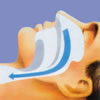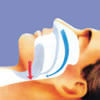What is Obstructive Sleep Apnea?
Obstructive Sleep Apnea (OSA) is a debilitating, often life-threatening condition that afflicts 18 million Americans or nearly 10 percent of the U.S.adult population. Obstructive Sleep Apnea is a sleep disorder in which a person’s breathing stops during sleep in intervals that may last from 10 seconds to a minute or longer as a result of a collapsed airway that prevents air from getting to the lungs. These “apneic events,” which can occur as frequently as 60 times an hour or up to 400 times a night, disrupt healthy sleep and cause a number of short-term and long-lasting effects that threaten sufferers’ health and well-being.
Normal Breathing

- Airway is open
- Air flows freely to lungs
- Brain rests
Obstructive Sleep Apena

- Airway collapses
- Airflow is blocked
- Brain is kept on alert, therefore unable to effectively rest
What Causes the Airway to Collapse During Sleep?
- Extra tissue in the back of the airway such as large tonsils.
- Decrease in the tone of the muscles holding the airway open.
- The tongue falling back and closing off the airway.
Are you at Risk?
Long-term Health Risks!
Clinical studies have shown that OSA can occur in men, women and children of all ages and sizes. While OSA diagnoses tend to be more prevalent among men, studies have shown that women and children are less likely to be evaluated, leading to lower diagnoses rates.
What is the treatment for Obstructive Sleep Apnea?
The most common treatment is:
- CPAP (Continuous Positive Airway Pressure), pronounced “see-PAP”. Other less common treatments include surgery and oral applications, which may be effective in certain individuals.
- Any treatments should include weight loss if needed, exercise, and avoidance of alcohol, sedative, and hypnotics.
